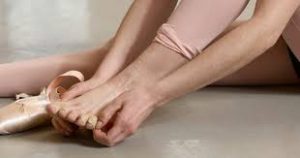
Ballet is all about strong, graceful lines. Sickled feet are an artistic error — an incorrect way to hold the foot, and they’re a health risk, too. Sickling makes dancers more vulnerable to foot and ankle injuries.
What exactly are sickled feet?
Sickled feet are not a health condition. Sickling is a behaviour — a foot position that can lead to ankle instability, tendonitis and injury.
When a dancer’s foot is sickled, the toes curve inward, and the heel drops back. This position distorts the continuous visual line running straight down the dancer’s shin and through the foot.
From a dance perspective
The dancer’s foot should be “extended as much as possible, with the instep forced well outward, and the pointe forced well downward.” It is a “serious error” when the dancer “forces the foot inward instead of outward” so that “the point is forward and the heel is backward.”
Sickling the foot inward is more common-almost like a ‘banana foot’.
Sickling can happen in almost any dance movement or position: relevé, retiré, élevé, glissade, jeté — you name it. Any time a dancer points their foot on the barre, in the air, or on the ground, it can be sickled inward or outward.
Turning out the foot correctly doesn’t start with knees or ankles. Correct foot position begins in the backside. The pelvis is responsible for turnout. When a dancer does not have enough strength to maintain turnout from the hip, or when a dance teacher demands an overly bevelled foot, then you can create muscle memory in a position that leads to injury. Instead, turn out from the hip and present the heel forward.
From a medical perspective
The medical term for a sickle with toes in is supination. In this supinated position, the peroneal tendons located on the outer ankle are stretched, which can lead to pain, weakness, and injury.
Sometimes chronic ankle instability leads to sickling, and sometimes sickling leads to peroneal tendons that are stretched and not as strong. Then you get that chronic ankle instability.
Why do ballet dancers sickle their feet?
It all comes down to training. Training builds strength, deepens a dancer’s understanding of technique, and develops an awareness of the body. Dance training is especially important to understanding and preventing sickled feet.
Proprioception
Newer dancers may not have a developed awareness of how their feet are oriented or positioned — a skill called proprioception . Without this keen awareness, dancers may not yet feel when they are executing a movement incorrectly.
With proper training, dancers can sharpen their ability to sense when their limbs are not positioned properly. Professional ballet dancers have a well-developed awareness of the position of their ankle, knee, and hip joints that allows them to move efficiently.
Strength
Sickling can happen when a dancer isn’t yet strong enough to hold the foot in the correct position consistently.
With time and training, a dancer can build strong glute, leg, ankle, and foot muscles so that sickling is less of a problem. Professional dancers who spent years developing strength and skill sickled their feet much less often during jumps than athletes who had little or no dance training.
Endurance
When dancers are fatigued—by repetitive jumps, for example—it’s more likely that the biomechanics of the ankle will change in ways that could lead to injuries.
To build endurance and prevent lower-body injuries, dancers should also focus on developing their core stability.
Can you prevent sickled feet?
While some dancers have stiff feet or feet that tend to sickle naturally, early intervention and proper training can make a big difference. Here’s what the experts recommend.
To develop proprioception:
- Sit on the floor with legs extended in front.
- Close your eyes, flex your feet, and then slowly point the toes.
- While the toes are still pointed, open your eyes and notice how the feet are pointing.
Many times, dancers are sickling or turning out from the ankles. Repeating the exercise can help dancers become aware of what the correct position feels like.
The bottom line
Sickling is a ballet term that means a dancer is curving the foot in a direction that is not favoured artistically and can be potentially damaging to the foot and ankle.
Sickling can lead to weakness in ankle tendons and chronic ankle instability, making them more vulnerable to injuries like tendonitis, sprains, and fractures.
To correct sickling, dancers need to develop both physical strength and more advanced awareness of how they move. Training with the right dance teacher or working with a physical therapist who specializes in treating dancers may be necessary to correct sickled feet before they cause injury.
If you’re a dancer devoted to the beauty of ballet’s lines, caring for your body is key — and that includes keeping your feet strong.
#stepandstridepodiatry #respod
Call us today to resolve your foot problems.
0800 473 776
(09) 212 9612
